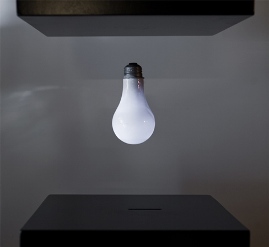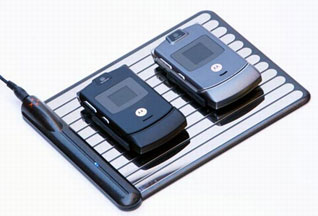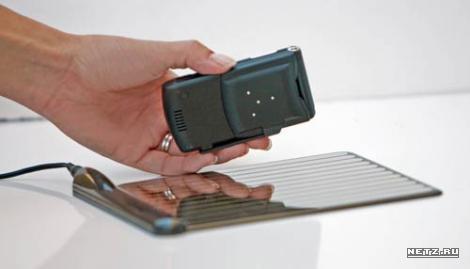Categories: Featured Articles » Interesting electrical news
Number of views: 55654
Comments on the article: 1
Working technology for wireless charging portable devices
Wireless electricity. Background
In 1996, engineer Roy Kuennen struggled to solve one problem: how to make Amway Corp a household water purifier. didn't break? The filter killed the bacteria with an ultraviolet lamp, but for this it had to be immersed in water. The wires that supplied the lamp with electricity rusted. Then engineer Kuennen had a crazy idea: remove the wires and feed the lamp remotely - using a magnetic coil.
While Kyuennen was tormented with a water filter, the wireless revolution was already in full swing - starting in the 90s, she gave us a cell phone, Bluetooth and Wi-Fi, but only in recent years began to cover the area of power supply. Several companies are now looking for ways to supply electricity to mobile phones, PDAs, laptops and other gadgets directly, without the need to connect them to the network.
The first such products have already entered the market - for example, the charging "mat" for the Motorola Razr phone, developed by WildCharge. It does not consume much energy, as it comes in direct contact with the phone itself. However, the initial idea of Kyuennen - to charge devices remotely - this does not correspond. 12 years after his experience with a filter for water purification, he is ready to introduce a truly contactless charging technology into everyday life.

Kuennen used the old idea of energy transfer through a magnetic field, voiced by Faraday and Tesla. The current passing through the wire spiral creates an electromagnetic field; under the influence of this field in another spiral located nearby, a current also appears. Fulton Innovation, one of the founders of Kyuennen, this year may launch a device that charges various gadgets with a magnetic coil hidden under a desktop or other surface - it transfers electricity to a second, smaller coil inside the charged devices.
ECoupled electric table for charging mobile devices
 The company called this technology eCoupled and has protected it with dozens of patents. What is new in it? After all, electric shavers and toothbrushes are already being recharged using electromagnetic induction. As the developers explain, for the first time they managed to create a system for automatically setting the charger to the charging parameters. The fact is that all the currently produced “magnetic” devices are closely connected with a charger (base where they are put at night).
The company called this technology eCoupled and has protected it with dozens of patents. What is new in it? After all, electric shavers and toothbrushes are already being recharged using electromagnetic induction. As the developers explain, for the first time they managed to create a system for automatically setting the charger to the charging parameters. The fact is that all the currently produced “magnetic” devices are closely connected with a charger (base where they are put at night).
Each such device has its own, individual, charging; In addition, the slightest deviation in the arrangement of devices - and the process of recharging the batteries almost dies out. eCoupled is capable of charging any devices equipped with an on-board “receiving” device, and a rechargeable device can be moved quite freely relative to the source. If the rechargeable device is a few centimeters from the eCoupled “point”, only 2% of the energy is lost “in the air”; but at a greater distance, of course, the losses increase.
According to Fulton, eCoupled technology will allow you to create convenient hot spots - just place the transmitter under the table, and your phone, computer, player, etc. will receive your portion of power on the surface. Farewell to the wires and power supplies that you lose forever.

“So it will be possible to charge the car [with electric drive] in the future,” says Dave Baarman, Fulton’s director of advanced technology. At an exhibition in Las Vegas, Baarman recently demonstrated how different devices can be powered through plastic and water. The most spectacular demonstration was the preparation of a steak on an electric grill, which had no wires.Many were impressed with the prospects of the technology even before the exhibition - now, among the partners of Fulton Innovation, such giants as Bosch, Motorola and Lenovo. They are developing devices compatible with eCoupled - so far, in order for this technology to work, a special adapter must be connected to the phone or player. But soon they will be built-in.
Powercast Wireless Christmas Tree
Fulton has competitors using other technologies. For example, Powercast launches an artificial Christmas tree decorated with wireless LEDs. In a tree trunk - a radio transmitter that sends high-frequency signals in all directions. The outgoing energy causes the diodes to glow. During the year, Powercast sold about 500 of these trees for $ 395 each.
Radio wave energy for powering portable devices
Scientists from the American company Ambient Micro, about the development of which Newsweek wrote two years ago, went even further: they suggested using the free energy of radio waves, which are abundant in the surrounding space. “There is bad news - it is not yet possible to“ feed ”a laptop computer. But there is a good one: the amount of energy that is required to power various electronic devices decreases very quickly. What yesterday required several watts today is powered by milliwatts, and tomorrow by microwatts, ”said Scott Wicker, president of Newsweek.
It was assumed that the Ambient Micro device, "sucking out" gratuitous energy from radio waves, will go on sale this year at a price of $ 1 and will be able to power security sensors or RFID tags. Scott Vicker now admits that these plans turned out to be too optimistic. “We have so far failed to create a device that would interest investors,” he says. Vicker, by the way, does not consider Fulton Innovation a competitor: “Their device is more efficient, but they need to spend electricity to create a magnetic field, and we capture energy from the air.”
Marine Solyachich from the Massachusetts Institute of Technology experimentally proved that Ambient Micro and Fulton Innovation technologies have a lot to develop: a scientist, using the principle of magnetic resonance coupling, was able to light a lamp located two meters from the transmitter last year. Solyachich is sure: soon wireless electricity will feed much more serious appliances - toasters, stoves, PCs and vacuum cleaners.
But there is a difficult choice: between comfort and energy saving. The greater the distance between the energy source and the device, the more energy is lost during transmission. “The power of wave sources can be different,” says Zoya Popovich, a professor at the University of Colorado. - You can use a magnetic field or radio waves. But recharging efficiency depends on the distance the devices are located. ” For example, when replacing outlets and wires with magnetic coils, you will have to accept that at least 50% of the electricity will go nowhere.
This is certainly a profitable exchange, if we are talking about an electronic stimulator of the heart, consuming a minimum of electricity. But powering a toaster or TV can be too expensive. However, more and more convenience in operation is the main factor on which the success or failure of a product depends.
An alternative to a wireless charger is the WildCharge wireless device, which charges gadgets through their surface.
WildCharge won the CES 2008 Best Innovation Award in the portable power category. And last month, the device received the TIME Magazine Award in the category of the best invention of 2007.
Wildcharge was established in 2005 to promote the unique, now patented technology for wireless power transmission. With the help of such a wonderful rug, you can forget about the chargers for cell phones, music and video players, and even laptops. One caveat - all these devices must be equipped with a special adapter.
Miracle Rug WildCharger
The charger called WildCharger is a horizontal substrate with strips of contacts and is designed to recharge all kinds of gadgets: mobile phones, players, etc. Each of the charged devices must be equipped with a special adapter. When the user places the phone on the substrate of the charger, the adapter contacts in contact with its surface, forming a closed electrical circuit. The adapter can be purchased separately, but you can add the corresponding function to the gadget during the production process.
This ensures 100% energy transfer without the occurrence of harmful magnetic fields. According to WildCharge officials, engineers have been working on the development of the device since 2001. The backing can charge up to five gadgets at a time. The charger currently supports Motorola RAZR phones sold by some carriers. Over the coming months, the number of supported gadgets is planned to increase and include iPod Nano and iPhone.
You can buy WildCharger on the manufacturer’s website at a price of $ 60. Other companies are developing similar chargers. So, at the end of last year, Belkin introduced the Pitstop concept, which allows you to charge devices wirelessly. The basis of his work was the use of inductance rings.
See also at bgv.electricianexp.com
:
